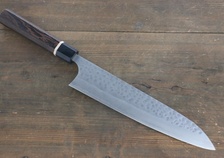Blog
5 Features To Look for When Buying a Professional Chef’s Knife
Nothing beats preparing your own meals. Forget about fancy restaurants or gourmet food caravans. With just a couple of fresh ingredients and the right tools, you’ll be able to cook up a meal worthy of a king. We can’t give you any tips on how to prepare delish food, but we can certainly teach you a thing or two about knives. Yes, in this article you’ll find everything you’ll ever need to about how to choose a professional chef’s knife.
Why Should I Bother Buying a Professional Chef’s Knife?
Two words – they’re cool! Still not convinced? A chef’s knife is a versatile kitchen utensil. Imagine that instead of a drawer full of low-quality knives, you could buy one that can be used to slice and dice virtually anything.
Of course, the better the knife, the pricier it becomes. Don’t go out there thinking that you can purchase a premium quality chef’s knife for 20 bucks, because, chances are, that you’ll probably end up with a fake one.
High-quality chef’s knives can cost up to $500, depending on the materials used to manufacture it and, of course, retailer. Although the price could seem out of reach, it’s an investment worth making. Think of it this way – premium quality chef’s knives are for a respectable cook what a handmade Rolls Royce is for a CEO.
There are many things to take into consideration when purchasing a chef’s knife – what shape should I get? can I use it to slice more than vegetable? What about maintenance? Here’s an excellent example of how shape can affect the knife’s overall performance.
Dimple-style blades, like the Mac MTH-80 Professional Series 8-Inch Chef Knife with dimples, are better at chopping hard vegetables or fruits such as winter squash, sweet potatoes or beetroots because those indentations help the blade hack through the pulp. On the other hand, classic chef’s knives are better at slicing through tendons and even breaking bones since the design permits a thicker heel.
What to Look for in a Pro Knife?
Now, let’s take a closer look at the things that make up a professional chef’s knife.
1. Size
While it’s true that size doesn’t always matter, this doesn’t apply to chef’s knives. The size of the blade (distance from the tip to where the heel ends) determines how easy or hard it is to maneuver the knife.
Typically, a chef’s knife’s blade has at least 8 inches. However, longer or shorter versions are available on the market. Knives with 10-inch blades can process a larger volume of meats or vegetables but tend to feel a little uncomfortable. If you’re one for agility, you can opt for the 6-inch version, which works like a charm if you need to slice and dice on the run. Just be careful not to chop off your fingers.
2. Weight
The weight criterion is very subjective. What wanted to say was that there are some chefs who prefer heavier knives for that extra kick and, of course, those who would take a lighter blade any day. While we can’t make any recommendations on this, our suggestion is to try out as many chef’s knives as possible to figure out which one works best for you. If there’s a kitchen utensils store in the area, you could ask the salesperson to let you try out a few knives.
3. Balance
Balance is a crucial factor when choosing a chef’s knife. To determine if the knife you’re about to buy suits your needs, try the following trick: hold out three fingers, place the knife, and move it a little to find its center of gravity. A good quality knife should be perfectly balanced. On the other hand, if you feel that the knife is heavier in the back or in the front, it means that it’s not properly balanced.
Such a knife will make chopping much harder. Furthermore, an improperly balanced chef’s knife feels unstable in hand, especially when you bring it down on the board.
4. Handle
The handle also plays an essential role. Without a good grip, even a top-notch chef’s knife would be useless. While some professional knives have bare handles (they’re just bare, steel followed by steel), most have some sort of coating – silicone, rubber or plastic. Again, choose one that feels comfortable. Here’s tip to help you determine which one’s the best for you: pour some water on the hand you use to maneuver a knife and then try to chop up something. If the knife stays in your hand, then it’s a match made in heaven.
5. Sharpness
Did you know that you can actually tell if a chef’s knife is made from high- or low-quality steel during the unboxing? As a rule of the thumb – if super sharp when you take it out of the box, it means that it’s the real McCoy. Moreover, a chef’s knife made from top-notch steel doesn’t need to be sharpened on a weekly or monthly basis. However, you’ll still need to give a good sharpening from time to time, because meats and vegetables to tend to take their toll on the blade.
Conclusion
So, if you want to buy a professional chef’s knife, you need only follow a couple of simple rules and hone those kitchen skills. Don’t be cheap, try out before you buy. And last, but not least, have a blast!











Comments